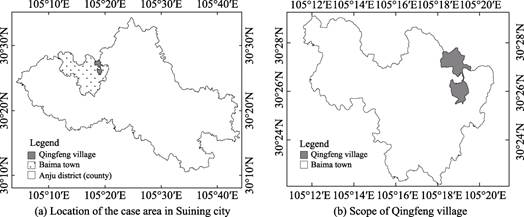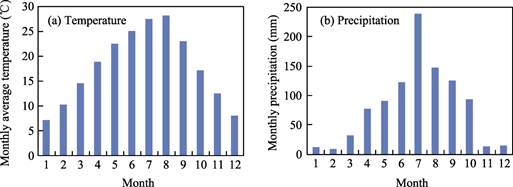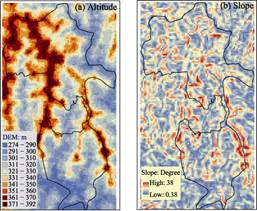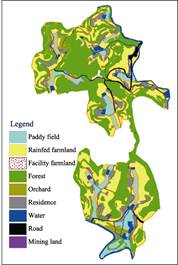Suining Sweet Potato Subtropical Hills in Qingfeng Village, Baima Town, Sichuan Province
Abstract
Suining sweet potato is a group of traditional quality varieties which have been cultivated in Suining of Sichuan for hundreds of years. Of which, “Suining 524” has been cultivated for 60 years, it has uniform tubers and light brown skin, and contains a large amount of starch, soluble sugar, various vitamins and amino acids, and also contains protein, fat, dietary fiber and minerals such as calcium and iron. Sweet potato is one of the staple crops in Qingfeng village, Baima town, Suining city. It is planted intensively and continuously, forming a unique planting method and management mode. Over the years, Suining sweet potato has formed a cultural and geographical tradition with regional characteristics in the environmental protection and life of villagers in Qingfeng village. This case study developed five types of data of Qingfeng village: (1) case boundary (village, town, county); (2) habitat environment (climate, DEM/Slope, soil, water quality, NDVI, land use); (3) sweet potato agronomic feature, nutrition and safety; (4) enterprise and management; (5) photos and pictures. The dataset is archived in .shp, .tif, .xls, and .docx formats, and is 60 MB in size.
Introduction
Sweet potato (Ipomoea batatas (L.) Lam.) is an annual or perennial dicotyledonous herb of the genus Ipomoea in the family Convolvulaceae, commonly known as sweet potato, yam, red camp, red potato, groundnut, white potato, and white taro. It is the seventh largest food crop in the world, originating in tropical America ranging from Mexico, Ecuador to Peru. It is a thermophilic, light-loving, not cold-resistant crop. It is grown in more than 120 countries and regions from temperate to tropical regions south of 40ºN latitude, and was introduced to coastal Fujian and Guangdong of China at the end of the 16th century[1–4].
Qingfeng village is 30 km away from Suining city and 20 km away from Anju district. Qingfeng village is located in the hilly area in the middle of Sichuan province. The appearance of the region is mainly gentle hills and basins, with an altitude of 300-600 m. The overall terrain is high in the northwest and low in the south. The terrain slope is mostly about 6-15 degrees. The soil in Qingfeng village is mainly red brown purple soil and brown purple soil, which are weakly alkaline, and the soil layer has high potassium content. The soil has strong permeability, water and fertilizer retention, is conducive to the growth of sweet potato and the formation of nutrients, and has favorable conditions in improving the stress resistance of sweet potato plants. Located in the subtropical humid monsoon zone, the case area has annual average temperature of 17.6 °C, annual average rainfall of 800–1,000 mm, and annual average frost-free period of 283-300 d, all are suitable for a variety of crops.
Qingfeng village has arable land area of 4,252.86 mu (1 mu = 666.67 m2), of which 2,800 mu is for sweet potato, accounting for 65% of the total arable land. The per capita sweet potato area is 5.7 mu, mainly for the 524 variety of Suining sweet potato. The sweet potato yield of Qingfeng village in 2020 was 5,000 tons, with value of 10 million Yuan. The yield per mu was about 1,000 kg and the income per mu was about 1,500 Yuan. After the establishment of the industrial park, the village’s collective income has increased by 100,000 Yuan in 2021. With 1,000 mu demonstration field, the Suining sweet potato Industrial Park is providing service to 8,000 mu of sweet potato managed by professional cooperatives, large farmers, and 5,000 small-hold households, 3,000 of which used to be poor households.
Metadata of the Dataset
The name, author, geographic region, data time, dataset composition, data publishing and access platform, and data sharing policy[5] are shown in Table 1.
Table 1 The metadata summary of the dataset[5]
| Items | Description |
|---|---|
| Dataset full name | Suining sweet potato subtropical hills in Qingfeng village case dataset on ecosystem protection and sustainable development |
| Dataset short name | SuiningSweetPotatoCase13 |
| Author | Tan, W. F., Institute of Crops, Sichuan Academy of Agricultural Sciences, zwstwf414@163.com Li, L. S., Agricultural Product Inspection and Monitoring Center, Suining City, Sichuan Province, 373086581@qq.com Yang, X. L., Agriculture and Rural Affairs Bureau of Suining City, Sichuan Province, Email: 296074762@qq.com Chen, Z., Bureau of Natural Resources and Planning, Suining City, Sichuan, Email: Dong, Y. L., Suining Longting Ecological Agriculture Co., Ltd. Zhao, R., Bureau of Agriculture and Rural Affairs, Suining City, Sichuan Province Long, X. C., Bureau of Agriculture and Rural Affairs, Suining City, Sichuan Province Li, Y., Suining Agricultural Product Quality and Safety Center Yang, S. T., Institute of Crops, Sichuan Academy of Agricultural Sciences, yost60@126.com Wang, Z. X. L-5255-2016, Institute of Geographic Sciences and Natural Resources Research, Chinese Academy of Sciences, wangzx@igsnrr.ac.cn |
| Geographical area | Qingfeng village, Baima town, Suining, centered at 105°19′E and 30°27′N |
| Year | 2020-2021 |
| Data format | .shp, .tif, .xlsx, .docx, .jpg |
| Data size | 60 MB |
| Data files | (1) Location data of the case area; (2) physical geography data; (3) sweet potato characteristic data; and (4) management data |
| Foundation | Ministry of Science and Technology of P. R. China (2020YFD1000803-2) |
| Publishing platform | Global Change Research Data Publishing & Repository, http://www.geodoi.ac.cn |
| Data publisher address | No. 11A, Datun Road, Chaoyang District, Beijing 100101, China |
| Data Sharing Policy | Data from the Global Change Research Data Publishing & Repository includes metadata, datasets (in the Digital Journal of Global Change Data Repository), and publications (in the Journal of Global Change Data & Discovery). Data sharing policy includes: (1) Data are openly available and can be free downloaded via the Internet; (2) End users are encouraged to use Data subject to citation; (3) Users, who are by definition also value-added service providers, are welcome to redistribute Data subject to written permission from the GCdataPR Editorial Office and the issuance of a Data redistribution license; and (4) If Data are used to compile new datasets, the ‘ten per cent principal’ should be followed such that Data records utilized should not surpass 10% of the new dataset contents, while sources should be clearly noted in suitable places in the new dataset[6] |
| Communication and searchable system | DOI, CSTR, Crossref, DCI, CSCD, CNKI, SciEngine, WDS/ISC, GEOSS |
DOI: https://doi.org/10.3974/geodp.2022.02.02
CSTR: https://cstr.escience.org.cn/CSTR:20146.14.2022.02.02
Dataset Availability Statement:
The dataset supporting this paper was published and is accessible through the Digital Journal of Global Change Data Repository at: https://doi.org/10.3974/geodb.2022.05.09.V1 or https://cstr.escience.org.cn/CSTR:20146.11.2022.05.09.V1
Eco Geographical Environment of the Case Area
Geographical Location and Scope
The case area is at Qingfeng village, Baima town, Anju district, Suining city, Sichuan province, with a total area of 4.29 km2. Its geographical center is at 105°19′E, 35°30′27′N (Figure 1).
Climate
The average annual temperature in case area is 16.7-17.4 °C with a maximum of 39.5-40.4 °C and a minimum of –3.8−–4.8 °C, and with 283-300 days of frost-free period. The
average annual rainfall is about 887.3-927.6 mm, and variation between the maximum and the minimum is 867.7 mm. The average annual solar radiation is 87.41-93.36 kcal/cm2, with 1,300.4-1,328.1 hours of sunshine per year. The average annual evaporation is 910.7- 1,128.3 mm and the average annual relative air humidity is 80%-82% (Figure 2). The normal growth of sweet potato requires an air temperature above 15 °C, temperature also affects the quality of root tubers. In the range of 18–32 °C, the higher the temperature, the higher the sugar content. Figure 2a shows that the case area is suitable for sweet potato growth from April to October. There is usually no serious natural disaster of floods or winds in Suining. Sprinkler irrigation system is used in case of drought. Pests and diseases are mainly prevented by implementing physical pest control measures such as yellow boards and insecticidal lamps.
Topography and Geomorphology
Suining lies in the central hilly area of Sichuan Basin, with simple geological structure and gentle folding. This hilly landform is formed by the Mesozoic Jurassic rock formation after being eroded and piled up by water system. The elevation of the hills is between 300 and 400 m. The ground is gentle, with only a few areas higher than 25 degrees. The general topographical features are: Firstly, it is high in the northwest and low in the southeast; secondly, the slope of hills is gentle; and third, the scattered alluvial flatlands lie among the hills (Figure 3).
Soil
Soil properties: According to the soil census data of Suining, the soil samples within Qingfeng village are T41 and T43, and the adjacent soil samples are T44 and T45 (Table 2). The soil in Qingfeng village is mainly reddish-brown-purple soil and brown-purple soil, and the soil pH is 7.85–8.42, which is weakly alkaline. The soil organic matter in the case area is 15.5–21.3 g/kg, and the available potassium is 175–222 g/kg, which is beneficial to the development of sweet potatoes.
Soil safety: soil quality not only affects the growth of sweet potato, but also affects the quality and safety of sweet potato[7,8]. The soil heavy metal contents are important indicator of environmental safety of sweet potato cultivation. The soil sample was collected in Qingfeng village and major soil metals were analyzed by implementing X-ray fluorescence method. The results of soil chemical element analysis are shown in Table 3. Compared with the national standard “Green Food—Habitat Environmental Quality” (NY/T 394—2021), the six heavy metal contents of the three soil samples all conformed to the national standard and were far below the limit values. In other word, the soil in the case area can produce sweet potatoes of green-food grade.
Table 2 Soil Nutrients of four soil samples in Qingfeng village
| Soil Samples | T41 | T43 | T44 | T45 |
|---|---|---|---|---|
| pH | 8.27 | 8.37 | 8.42 | 7.85 |
| Organic matter (g/kg) | 21.3 | 15.5 | 13.3 | 46.1 |
| Available phosphous (mg/kg) | 8.8 | 16.9 | 4 | 10.9 |
| Total nitrogen (g/100g) | 0.134 | 0.116 | 0.094,4 | 0.252 |
| Available potassium (mg/kg) | 175 | 222 | 145 | 168 |
| Slow-acting potassium (mg/kg) | 691 | 830 | 727 | 420 |
| Alkali-hydrolyzed nitrogen (mg/kg) | 98 | 78 | 70 | 179 |
| Available iron (mg/kg) | 9.62 | 3.37 | 2.88 | 119 |
| Available manganese (mg/kg) | 2.27 | 2.88 | 3.3 | 31.9 |
| Effective copper (mg/kg) | 0.87 | 0.632 | 0.342 | 2.18 |
| Available zinc (mg/kg) | 0.3 | 1.48 | 0.608 | 1.01 |
Table 3 Comparison between the soil metals in case area and the national standard (mg/kg)
| Element | Abbreviation | Test results and standard limits | NY/T 391—2021 | ||||
|---|---|---|---|---|---|---|---|
| Site 1-1 | Site 1-2 | Site 1-3 | Limit | Single pollution index Pi | Individual judgment | ||
| Arsenic | As | 6.67 | 6.98 | 6.64 | ≤20 | 0.33 | qualified |
| Cadmium | Cd | 0.18 | 0.18 | 0.18 | ≤0.4 | 0.45 | qualified |
| Chromium | Cr | 70 | 66 | 71 | ≤120 | 0.58 | qualified |
| Lead | Pb | 22.7 | 24.4 | 21.2 | ≤50 | 0.45 | qualified |
| Hg | Hg | 0.021 | 0.027 | 0.030 | ≤0.35 | 0.06 | qualified |
| Copper | Cu | 23 | 22 | 24 | ≤60 | 0.38 | qualified |
Irrigation Water Quality
Polluted water will not only reduce crop yield quantity, but also lower crop quality[9,10]. Sweet potato in the case area is mainly planted in rainfed land, irrigation is needed only during the dry spell. The irrigation water sample came from the main irrigation canal of Qingfeng village, and the water quality test results are shown in Table 4. Compared with the national standard “Green Food—Environmental Quality of Origin” (NY/T 394—2021), the quality of the water sample meets the need of the current national standards. It’s weak alkaline, with strong surface activity, good permeability and strong solubility. So it is easy to participate in a series of biochemical activities of cells, enhance the ability to fix nitrogen, and be beneficial to the green production by reducing fertilizer and pesticide. No major heavy metals were detected. The irrigation water of high quality guarantees pollutant-free sweet potatoes.
Table 4 Irrigation water quality in Qingfeng village
| Items | Limit value | Test results | Single pollution index Pi | Individual judgment | Comprehensive pollution index P |
|---|---|---|---|---|---|
| pH | 5.5-85 | 7.8 | 0.53 | qualified | 0.38 |
| Total mercury (mg/L) | ≤0.001 | not detected | 0.02 | qualified | |
| Total cadmium (mg/L) | ≤0.005 | not detected | 0.005 | qualified | |
| Total Arsenic (mg/L) | ≤0.05 | not detected | 0.003 | qualified | |
| Total lead (mg/L) | ≤0.1 | not detected | 0.0005 | qualified | |
| Hexavalent chromium (mg/L) | ≤0.1 | not detected | 0.02 | qualified | |
| Fluoride (mg/L) | ≤2.0 | 0.38 | 0.19 | qualified | |
| Chemical oxygen demand (mg/L) | ≤60 | 5 | 0.08 | qualified | |
| Petroleum (mg/L) | ≤1.0 | not detected | 0.005 | qualified | |
| Fecal coliforms (count/L) | ≤1,0000 | not detected | 0 | qualified |
NDVI
Vegetation cover is the comprehensive measure of crop development condition. Monitoring the status of vegetation cover can guide the field management of sweet potato. While the theoretical revisit time of Sentinel-2 satellite is 5 days, image with clear sky may be obtained once a month due to frequent foggy skies, which is a little rare, but it is still helpful for field management. Figure 4a shows the NDVI on June 5, 2020, showing that the vegetation at sweet potato seedlings period is low. Figure 4b shows the NDVI on August 9, 2020, when the sweet potato is at its full coverage.
Land Use
According to the Third National Land Use Survey Data (Figure 5, Table 5), the land types of Qingfeng village in 2020 are mainly dry land and forest land. The dry land area is 148.13 ha,
accounting for 34.51%; The forest land area is 181.51 ha, accounting for 42.29%; Facility farmland is 1.12 ha, accounting for 0.26%; The mine is 0.5 ha, accounting for 0.12%. Sweet potato is a waterlogging-averse crop and it grows best at the second and third steps of the dry land. A large proportion of dry land provides an ideal environment for Suining sweet potato, and the forest land above it mainly plays the role of soil and water conservation and microclimate regulation.
Table 5 Land use area and structure of Qingfeng village
| CODE | Land use class | Land use area (ha) | % of the total |
|---|---|---|---|
| 011 | Paddy field | 42.47 | 9.9 |
| 012 | Dry farmland | 148.13 | 34.51 |
| 013 | Facility farmland | 1.12 | 0.26 |
| 020 | Garden | 11.08 | 2.58 |
| 030 | Woodland | 181.51 | 42.29 |
| 060 | Mine | 0.50 | 0.12 |
| 070 | Residence | 28.58 | 6.66 |
| 100 | Road | 12.71 | 2.96 |
| 110 | Water body | 14.19 | 3.31 |
| Total | Paddy field | 429.20 | 100 |
Suining Sweet Potato Characteristics: Agronomy, Nutrition, and Safety
Agronomic Characteristics
Sweet potato is a biennial or perennial dicotyledonous plant of the genus Ipomoea in the family Convolvulaceae. The sweet potato vine grows more than 2 m at maturity and crawls on the ground. Sweet potato has underground root tubers, which are spindle shaped and have yellowish skin. Sweet potato varieties in the case area have uniform root size, thin skin, light skin, red color. Sweet potato leaves alternate, broadly ovate, 3–5 palmately divided. Sweet potato GAGs are axillary cymes, with small bracts, subulate, oblong sepals, unequal lengths, and corolla bell shaped, funnel-shaped, white to purple red. Capsule is ovoid or oblate, with 1-4 seeds. Sweet potato root tubers are rich in flour and can be eaten, brewed or used as feed.
The main sweet potato variety in the case area is “524 sweet potato”, which was introduced into Suining city in the early 1960s. Qingfeng village is one of the first pilot planting bases. Because the dry farmland slope in Qingfeng is mostly between 8-12 degrees, and the annual rainfall is about 1,000 mm, it can meet the water demand of red potato. At the same time, the red brown purple sandy soil has good air and water permeability, which is very ideal to sweet potato. The trial planting of this variety in Qingfeng was so successful that large-scale planting began in the next year of introduction, and almost every household planted 524 sweet potato, which has continued until now.
Nutritional Characteristics
The sweet potato samples for this quality test are collected from Qingfeng village on October 15, 2021. The analysis items include the main nutrients and amino acids (Table 6, 7). The results show that Suining sweet potato has higher soluble sugar content than other sweet potato varieties, so it has a unique taste of high sweetness. Suining sweet potato has higher starch content, which is conducive to further conversion into soluble sugar. While ensuring good taste quality, Suining sweet potato has a rich variety of amino acids necessary for human body, and no harmful heavy metals such as lead, mercury, cadmium and arsenic have been detected. The above data prove that Suining sweet potato has good taste quality, rich nutrition, and reliable food safety.
The planting area of sweet potato in Suining will expand to 150,000 mu. In the next five years, and the varieties of sweet potato will also increase accordingly. Suining city has reached an intention of cooperation with Liancheng county in Anhui province to carry out deep processing of sweet potato and will produce various sweet potato products such as starch, noodles, strips, slices, and sweet potato dries.
Safety of Suining Sweet Potato
Both indicators of heavy metals and pesticide residues of sweet potato in the case area meet the national standards (Table 6, 8).
Table 6 Nutrition and metals of sweet potato from Qingfeng village
| Item | Unit | Test result | Item | Unit | Test result |
|---|---|---|---|---|---|
| Protein | g/100g | 1.11 | Potassium | mg/kg | 300 |
| Fat | g/100g | 0.3 | Lead | mg/kg | not detected |
| Moisture | g/100g | 65.3 | Total mercury | mg/kg | not detected |
| Starch | g/100g | 20.3 | Cadmium | mg/kg | not detected |
| Phosphorus | mg/100g | not detected | Total arsenic | mg/kg | not detected |
| Soluble sugar | % | 7.05 | Vitamin C | mg/100g | 13.6 |
| Iron | mg/kg | 6.7 | Vitamin E | mg/100g | 1.31 |
| Calcium | mg/kg | 135 | Total carotene | mg/100g | 2.13 |
Table 7 Amino acid content of sweet potato from Qingfeng village
| Item | Unit | Test result | Item | Unit | Test result |
|---|---|---|---|---|---|
| Valine | g/100g | 0.087 | Glutamate | g/100g | 0.136 |
| Alanine | g/100g | 0.080 | Serine | g/100g | 0.103 |
| Proline | g/100g | 0.044 | Lysine | g/100g | 0.075 |
| Threonine | g/100g | 0.074 | Arginine | g/100g | 0.054 |
| Phenylalanine | g/100g | 0.084 | Histidine | g/100g | 0.025 |
| Leucine | g/100g | 0.095 | Tyrosine | g/100g | 0.051 |
| Methionine | g/100g | 0.010 | Aspartic acid | g/100g | 0.291 |
| Glycine | g/100g | 0.058 | Isoleucine | g/100g | 0.055 |
Table 8 Pesticide residue of sweet potato from Qingfeng village
| Item | Unit | Test result | Limit value | Determination |
|---|---|---|---|---|
| Imidacloprid | mg/kg | 0.000,55 | / | / |
| Doingling | mg/kg | 0.000,12 | / | / |
| Methamidophos | mg/kg | 0.001,23 | ≤0.05 | qualified |
| Omethoate | mg/kg | 0.002,41 | ≤0.02 | qualified |
| Dimethoate | mg/kg | 0.001,9 | ≤0.01 | qualified |
| Budweiser | mg/kg | 0.003,27 | ≤0.02 | qualified |
| Dichlorvos | mg/kg | 0.01 | ≤0.2 | qualified |
| Hexachlorocyclo-hexane | mg/kg | 0.01 | ≤0.05 | qualified |
| Chlorpyrifos | mg/kg | 0.01 | ≤0.02 | qualified |
| Triazolone | mg/kg | 0.01 | / | / |
| Endosulfan | mg/kg | 0.01 | ≤0.05 | |
| Fenvalerate | mg/kg | 0.01 | / | / |
| Deltamethrin | mg/kg | 0.01 | / | / |
Social Economy and Management of the Case Area
People and Land of Qingfeng Village in 2020
Qingfeng village is formed by two poverty-lifted villages (Qingfeng and Wolongqiao), covering an area of 5.4 km2, 4,252.86 mu of which is arable land (3,615.87 mu of dry land and 636.99 mu of paddy field; 1 mu=666.67 m2). There are 8 villagers’ groups, 736 households and 2,410 people in the village. “524 series” have been dominant sweet potato varieties since 60 years ago.
Sweet Potato Professional Cooperative: Longting Eco-Agriculture Co., Ltd.
Suining Longting Eco-Agriculture Co., Ltd. was registered in Suining in December 2012, with 330 employees and 5,000 mu of sweet potato base. The company’s business includes sweet potato variety R&D, deep processing, and sales. It is a provincial-level agricultural enterprise in Sichuan. The company improved the storage technique, invented the all-season seedling and planting technique, and realized the sales of sweet potato throughout the year.
The company uses abandoned land to expand the sweet potato planting area, and works with the Crop Research Institute of Sichuan Academy of Agricultural Sciences to lead local farmers to develop the sweet potato industry. By improving marketing, standard setting, R&D, and risk prevention, the company has been building a sweet potato products link and has improved the competitiveness of sweet potato products.
Cultivation Specifications of Suining Sweet Potato
A set of sweet potato planting techniques have gradually formed over last 60 years (Table 9).
Table 9 Specifications for cultivation and management of sweet potato
| Stage | Duration | Main agricultural activities |
|---|---|---|
| Seedbed | Feb. –May | Double-film seedling raising in greenhouse, fertilizer and water management |
| Growing | Apr. –Nov. | Cuttings, artificial weeding, physical pest control, organic fertilizer |
| Harvest | Mid Jul.–mid Nov. | Lightly collected, graded, and transported |
| Storage | Mid Jul.–Next Jul. | Commodity fresh potato baskets are stored in cellars. Initially, sweet potatoes are dehumidified. Then keep the cellar conditions at temperature= 10–14 °C, moisture = 85%, and CO2 < 4% |
| Processing | Late Oct.–mid Nov. | Starch processing starts one week after harvest. Starch derivatives like vermicelli can be produced on an annual basis |
| Sale | Early Aug.–Next Jul. | Fresh sweet potatoes are sold after 20 days of storage, and sold by grade |
Horizontal cutting and moderate dense planting method: 3−4 stem nodes of sweet potato branches are horizontally planted in the soil, and the cutting density is 60,000 plants / ha. In Suining area, commercial sweet potatoes of 50–150 g can be produced at such density.
Extend the sweet potatoes shelf life by multi-time breeding, transplanting and harvesting: The first-time breeding starts in mid and late February, the first-time transplanting completes in early April, and the last-time transplanting finishes in late June. In mid July, the first-time potatoes start to be harvested. For comparison, the late-time sweet potato begins to be harvested in November. Plus the storage time, it can be sold until next July. In other words, sweet potatoes in the case area can be sold all year round.
Sweet potato seedling raising by three-layer covering: due to the low temperature in February, the accumulated temperature required for sweet potato seedling raising is not sufficient. The three-layer covering technique is developed to uplift land surface temperature and to prevent seedlings from freezing: large arch shed, small arch shed, and surface plastic film.
Strictly control the use of chemical fertilizers and pesticides: to ensure the taste of sweet potato and control the size, Suining sweet potato specifications stipulate that chemical fertilizers and pesticides shall not be used. The quality and safety department of agricultural products and Suining sweet potato professional committee are responsible for supervising and inspecting the sweet potato producers and product sampling inspection. Once violations are found, the use of trademark “Suining sweet potato” will be suspended; if the chemical residues of the sampled products exceed the standard, the agent concerned will be punished according to the relevant laws and regulations. Since the “524 sweet potato” variety has been planted in Suining for decades without diseases and pests, no pesticide is needed. To make the “524 sweet potato” look good, taste good, and with even and moderate size, farmers have been asked to control the use of fertilizers, especially chemical fertilizers, so farmers do not use chemical fertilizers when planting sweet potatoes, and even farmyard manure is underused. Thus, compared with other crops, sweet potato can save 50 kg of compound fertilizer of 15:15:15 of nitrogen, phosphorus and potassium per mu.
Management
The Villagers’ Committee as an Enabler
The Villagers’ Committee has supported the sweet potato industry in Qingfeng by establishing land transfer cooperatives, labor professional cooperatives and stock economy cooperatives.
Richen locals
Sweet potato farmers may increase their income in the following six ways.
(1) Rent from the transferred land. (2) Salary from working in enterprises in the park. (3) The share capital obtained by investing in enterprise. (4) Income from family economy. (5) Bonuses from policy. The government provides various entities with subsidy funds to settle in Suining Sweet Potato Park to promote the sweet potato industry. (6) Revenue from brand premium.
Attract and Nurture New Farmers With Professional Knowledge
It’s significant to attract, nurture, and cherish talent to develop new rural economy. A total of 52 new type of highly qualified professional farmers have been introduced and trained to Suining Sweet Potato Industrial Park.
Assist Local Enterprises
Through training courses and symposiums about Suining Sweet Potato Park, help enterprises deal with thorny issues such as land circulation and employment, create a good environment for enterprise development. In 2021, four symposiums were held, and 12 difficult problems were solved through this mechanism.
Cultivation History of Sweet Potato in Suining
Sichuan province has the largest sweet potato planting area in China, and Suining city is the core area of sweet potato in Sichuan with a long planting history. Suining County Annals (1929) recorded: “There is insufficient food due to too few land and too much people in recent years, many live mainly with sweet potatoes”. There was a saying: “Sweet potato is equivalent to half a year’s food”. Even today, sweet potato by-products are still one of the main feed for pigs. Since the late Ming dynasty, sweet potatoes have been widely planted in Sichuan.
After adaptation, evolution, cultivation and selection, Suining sweet potato has gradually formed unique characteristics. Among them, the “524 sweet potato” variety mainly planted in Qingfeng village, Baima town has a planting history of 60 years, and three generations of Qingfeng people have summarized sweet potato cultivation experience. In October 2021, “Suining sweet potato” was certified as a “Geographical Indication Certification Trademark” by the State Intellectual Property Office[11]. It has formed a unique culture of agriculture in hilly areas of Central Sichuan, and is a valuable agricultural cultural heritage.
Discussion and Conclusion
Sweet potato, native to South America, was introduced to China during the Wanli period of the Ming dynasty. Over 400 years, sweet potato has been one of the staple foods in China. Suining is located in a hilly area at 30ºN, with a mild temperature and abundant rainfall. The unique climate makes Suining sweet potato unique in its soft, waxy, fragrant and sweet characteristics.
Taking Qingfeng village, Baima town, Anju district as a case, this paper makes a comprehensive analysis of the natural habitat and management of Suining sweet potato. Compared with the national standard Green Food-Environmental Quality of Origin (NY/T 394—2021), Suining sweet potato has qualified sanitary indicators, meets the requirements of green food, has high nutritional indicators, and is a quality geographical product. Since Suining sweet potato is planted in dry land by rotation without pesticides and fertilizers,it has no pollution to soil and water sources, and has the potential for sustainable development. Suining sweet potato’s good growth environment and standardized management ensure the sweet potato safety and provide a reliable traceability for sweet potato market and consumers. This is a win-win case to protect environment, develop local economy and promote rural revitalization.
References
[1] Ma, D. F., Li, Q.,Cao, Q. H., et al. Development and prospect of sweet potato industry and its technologies in China [J]. Jiangsu Journal of Agricultural Sciences, 2012, 28(5): 969-973.
[2] Liu, Q. C. Importance of sweet potato in the security of food and energy in China [J]. Science & Technology Review, 2004(9): 21-22.
[3] Dai, Q. W., Niu, F. X., Sun, J., et al. Change analysis of sweet potato production and consumption structure in China [J]. Journal of Agricultural Science and Technology, 2016, 18(3): 201-209.
[4] Cui, K. S., Feng, Y. P., He, J., et al. A new path for the development of Sichuan potato industry and its reference to the transformation and upgrading of China modern potato industry [J]. China Agricultural Technology Extension, 2020, 36(2): 5-8.
[5] Tan, W. F., Li, L. S., Yang, X. L., et al. Suining sweet potato subtropical hills in Qingfeng village case dataset on ecosystem protection and sustainable development [J/DB/OL]. Digital Journal of Global Change Data Repository, 2022. https://doi.org/10.3974/geodb.2022.05.09.V1. https://cstr.escience.org.
[6] cn/CSTR:20146.11.2022.05.09.V1.
[7] GCdataPR Editorial Office. GCdataPR data sharing policy [OL]. https://doi.org/10.3974/dp.policy.2014.05 (Updated 2017).
[8] Chen, Y. L., Weng, L. P., Ma, J., et al. Review on the last ten years of research on source identification of heavy metal pollution in soils [J]. Journal of Agro-Environment Science, 2019, 38(10): 2219-2238.
[9] Hu, W. Y., Tao, T. T., Tian, K., et al. Status and prospect of farmland soil environmental quality management in China [J]. Acta Pedologica Sinica, 2021(5): 1-18.
[10] Yin, P. H., Geng, R. Z., Pei, X. F., et al. Establishing an institutional framework for supervision and guidance of agricultural non-point source pollution control with the improvement of water environment quality as the core [J]. Environment and Sustainable Development, 2019, 44(2): 10-15.
[11] Liu, Y. Y. Study on the effect of different water quality on the taste and quality of Qimen black tea soup and its mechanism of action [D]. Hefei: Anhui Agricultural University, 2020.
[12] State Intellectual Property Office. National Geographical indication product—Suining sweet potato [Z]. http://sbj.cnipa.gov.cn/.
Case Team
Principle Investigator
Principle Investigator Song Xianfang
Song Xianfang, Institute of Geographic Sciences and Resources, Chinese Academy of Sciences, Professor, doctoral supervisor, chairman of the institute's workers' congress/trade union, deputy director of the institute's technology platform technical committee, professor of the University of Chinese Academy of Sciences, deputy director of the UAV Application and Control Center, Chinese Academy of Sciences, etc. Vice Chairman of the Isotope Hydrological Credit Committee of the Chinese Committee of the International Hydrological Association, Deputy Director of the Hydrogeology Professional Committee of the Chinese Geological Society, Guidance Committee Member of the Hydrogeology Professional Committee of the Chinese Geographical Society, Permanent Member of the Water Resources Professional Committee of the Chinese Natural Resources Society, and Committee Member of the Mining Water Committee of the Chinese Geological Society. Associate Editor in Chief of Geographic Research, Editorial Board Member of Water, Journal of Global Change Data&Discovery, Hydrogeology & Engineering Geology, Arid Land Geography, South to North Transfers and Water Science & Technology and Journal of Groundwater Science and Engineering.
Expert members of the case team
Yu Jiqun, Member of the Standing Committee of the Jilin Municipal Party Committee and Secretary of the Panshi Municipal Party Committee
Qi Wu Deputy Mayor, Panshi Municipal People's Government
Wang Zhengwen, Director, Panshi City Agriculture and Rural Affairs Bureau
Qiao Yunbo, Deputy Director, Panshi City Agriculture and Rural Affairs Bureau
Yang Lihu, Associate Professor, Institute of Geographic Sciences and Natural Resources Research,Chinese Academy of Sciences
Yao Dongxu, Research associate, Institute of Geographic Sciences and Natural Resources Research,Chinese Academy of Sciences
Fu Jingying, Associate Professor, Institute of Geographic Sciences and Natural Resources Research,Chinese Academy of Sciences
Du Xinglin, Professor, School of Plant Science, Jilin University
Wu Feng, General Manager, Panshi supply and Marketing Investment (Group) Co.
Liu Hongbin, Professor, Institute of Agricultural Resources and Regional Planning,Chinese Academy of Agricultural Sciences
Zhu Xiaoguang, General Manager, Beijing Tianhang Create Technology Co.,Ltd
Chen Cunhua, Section Chief, Panshi City Agriculture and Rural Affairs Bureau
Ren Jianxing, Clerk, Panshi City Agriculture and Rural Affairs Bureau
Wu Yunming, Secretary of the Town Party Committee, People's Government of Futai Town, Panshi City
Li Li, Secretary of the Town Party Committee, People's Government of Niuxin Town, Panshi City
Li Engui, Secretary of the Town Party Committee, People's Government of Jichang Town, Panshi City
Yao Liping, Secretary of the Town Party Committee, People's Government of Baoshan Township, Panshi City
Zheng Fei, Secretary of the Town Party Committee, People's Government of Songshan Town, Panshi City
Yan Guodong, Secretary of the Town Party Committee, People's Government of Hulan Town, Panshi City
Zhang Chuanmin, Secretary of the Town Party Committee, People's Government of Yantongshan Town, Panshi City
Pu Ri, Secretary of the Town Party Committee, People's Government of Quchaihe Town, Panshi City
Guo Chuanhai, Secretary of the Town Party Committee, People's Government of Chaoyangshan Town, Panshi City
Sun Zhigang, Secretary of the Party Working Committee, Fu'an Subdistrict, Panshi City
Gu Qiang, Secretary of the Town Party Committee, People's Government of Mingcheng Town, Panshi City
Zhou Liguo, Secretary of the Town Party Committee, People's Government of Hongqiling Town, Panshi City
Hu Hanyong, Secretary of the Town Party Committee, People's Government of Yima Town, Panshi City
Zhang Lijun, Secretary of the Town Party Committee, People's Government of Shizui Town, Panshi City
Sun Huifa, Secretary of the Party Working Committee, Fukang Subdistrict, Panshi City
Li Haisheng, Secretary of the Town Party Committee, People's Government of Heishi Town, Panshi City
Author Contributions
Yang, X. L. and Li, L. S. organized and coordinated the case study. Tan, W. F. and Yang, S. T. provided information on sweet potato varieties and cultivation, and wrote the manuscript. Chen, L. P., Long, X. C., Li, Y., and Luo, C. M. analyzed the sample data of soil, water, and sweet potato. Dong, Y. L. provided the information of professional cooperatives. Zhang, S. Y. provided basic data of Qingfeng village. Wang, Z. X. and Chen, Z. developed case area boundary, DEM/Slope, soil, NDVI and land use data.
Acknowledgments
The authors sincerely thank Liu, G. F., deputy director of Suining agricultural and rural Bureau, and Professor Liu, C., Institute of Geographic Sciences and Natural Resources Research, CAS, for their guidance to this study.
- Abstract
- Introduction
- Metadata of the Dataset
- Eco Geographical Environment of the Case Area
- Suining Sweet Potato Characteristics: Agronomy, Nutrition, and Safety
- Social Economy and Management of the Case Area
- Cultivation History of Sweet Potato in Suining
- Discussion and Conclusion
- References
- Case Team






